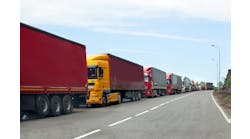Turning Up the Heat on Plastic Pallets
Ebb and flow are constants and constraints in our business. Issues come and go with the speed of buzz words. Some things, however, are elemental. Fire in the warehouse is one of those issues that will never go away. It will never be diminished or replaced by some new, more trendy buzz-thing.
So, it was with great anticipation that I awaited (since October 2001) to hear the results of the Reusable Plastic Container and Pallet Association’s (RPCPA is a product group within Material Handling Industry) testing program. The presentation of results at NA 2002 was as inconclusive as the tests. Testing was done in cooperation with TVA Fire and Life Safety, a fire protection engineering firm. TVA supplied the expertise and guidance for the tests, while six member-companies supplied pallets. Other interested parties ponied up the cash and technical support to find some resolution to the plastic pallet/fire conundrum. These companies included all the major resin manufacturers, the American Plastics Council, Tyco Sprinkler Company and Anheuser-Busch.
The end of the story is that the story is not over. Dan Tafaro, co-chairman of the testing committee, said there was not enough clear data to say, specifically, using plastic pallets justifies raising the fire classification of a warehouse. Nor does it support not raising the classification. Obviously, upping a classification creates a major expense (read barrier) for plastic pallet users.
Of the 15 plastic pallets tested, some fared better than wood; most others, however, did not. The final results will be voted upon by the National Fire Prevention Association (NFPA) in mid-May when the test results are made public. RPCPA hopes to change some of the standards relating to plastic containers and pallets.
Plastic pallets and containers in a warehouse are only one facet of the fire problem. Plastic gets most of the negative press because of the toxins it creates. While those toxins are similar to those created by corrugated and wood, they are in much higher concentrations when generated by plastic.
Even if your warehouse is “adequately” protected with sprinklers, there are hazards you should be aware of. Palletloads that are shrink wrapped are also resistant to wetting, providing a fuel source even after the sprinklers turn on. Stretch film and the volumes of plastic within cartons also become fuel components for a fire.
What about those fancy new lights you’ve installed in the building? Did you know that high-intensity discharge (HID) lights, particularly those made with metal halide, have caused fires?
Any fire is bad, and warehouse fires offer an additional challenge. Depending on the commodities stored, warehouse fires spread quickly and have a rapid increase in heat-release rates over short time periods. By their nature, warehouses are changing, dynamic environments. Third-party logistics providers are particularly vulnerable as the variety of incoming products changes constantly.
What can you do? Plenty. First, be sure your employees have clear instructions on how to minimize fire hazards. Regularly scheduled inspections should be part of your business plan.
Loss-prevention specialists recommend not using solid shelving in storage racks or placing product in the aisle that might impede water flow. They also advise having special routes through the warehouse for moving hazardous material.
Your best ally (aside from firefighters responding to your plea for help) is an adequate, automatic sprinkler system. This brings us back to the RPCPA testing program. The big question posed by NFPA is whether an automatic sprinkler system in a warehouse is designed for current storage arrangements, given the current guidelines. Your answer might be yes. But what if companies sending product to you suddenly initiate a plastic container program? Would you then be current? That’s the question RPCPA is attempting to answer. Keep in mind, fire codes are designed to reduce the opportunities for fires to start and spread. Sprinkler systems are not designed to extinguish fires. They are there to help control the spread of fire.
So, will plastic pallets and containers change your fire classification? Still hard to say. Classifications are based on the type of plastic and overall content, and measured by percent by weight for unexpanded plastics, and percent by volume and weight for expanded plastics. A simple change from paper-based packaging material to polystyrene, or from wood pallets to plastic, and it’s a whole new game.
I ran into John Clark at NA 2002. He’s a well-known and respected pallet researcher who recently left academia to work for a pallet manufacturer. I asked him for his take on the research of the RPCPA. He kind of grinned and handed me his new business card sporting the picture of a metal pallet.
Clyde E. Witt, executive editor, [email protected]


